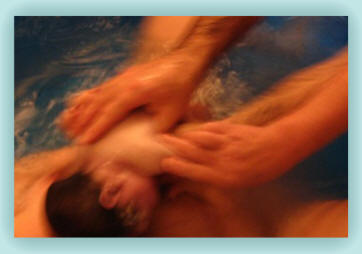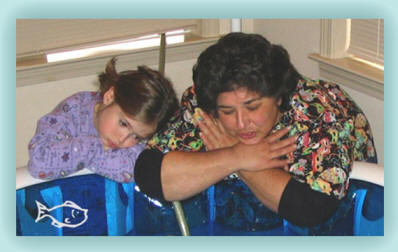

I’m often asked if we assist in water birth and our answer is “YES!” Most of our clients use water therapy of some kind during labor and some actually birth in the water.
Women have been finding comfort in water since the beginning of time. Warm water envelops the body creating a weightless feeling and diminishes the sensation of the contractions. As the body relaxes, adrenaline levels are lowered and endorphins are released. These hormonal painkillers reduce stress and lessen pain, allowing both physical and mental relaxation. Most women find their ability to concentrate is improved, allowing them to focus inward on the birth process. This promotes the progression of labor, making it easier, shorter and even enjoyable. The relief from the warm water is so good that it is worth bearing in mind that it can be used as pain relief even if you don’t want or plan to have a waterbirth.
Pain relief is an obvious motivation but there are other benefits to water. The buoyancy of the water gives a sense of weightlessness which makes it easier to change positions and eases the aches and pains of late pregnancy. Soaking in water lowers high blood pressure and increases blood circulation to the babies so they are born with higher oxygen levels. When mothers labor in the tub, there is less fetal distress and fewer complications such as hemorrhage, shoulder dystocia and meconium aspiration. The soaking is also good for mother’s bottom as it softens the perineum, making it easier to birth without tearing. Babies love being born into the familiarity of the water. They tend to be more alert and calm. You can literally see them unfold their limbs, open their eyes, and take in their new world. It’s a gentle transition from womb to mother’s arms.
But is it safe? A common concern we hear is, “how does baby breathe?” There is a complex physiological mechanism which inhibits the baby from taking a breath when it is born in water. It is commonly believed that the stimulus to breathe is from the baby’s face coming in direct contact with air. Up until the time that the baby is lifted out of the water, the baby receives its oxygen from the mother via the placenta and the umbilical cord. We have equipment to monitor the baby’s heart rate while you are in the tub and can carefully observe any changes in the labor.
Benefits of Waterbirth
• relaxation for mother
• pain management
• less need for medical intervention
• water creates support and equal pressure on all part of a
woman's body
• less energy used when birthing in water
• less pain
• less anxiety for mother and baby
• waterbirth seems to result in lower adrenaline (fight or flight
response) levels
• better oxytocin and oxygen flow to the mother
• blood supply to the uterus is increased and contractions are
more efficient as a result
an improved blood supply to the placenta during waterbirth also improves
the unborn baby's oxygen levels
• water results in a small decrease in the mother's blood pressure
and oxygen reaches the uterus and fetus with improvement
• the mother can fid a comfortable position more efficiently and
ease the descent of the baby through the birth canal
• warm water stops false labor contractions
• water provides flexibility
• a gentle transition for baby
• less risk of tearing and skin and tissue trauma for the mother
• less risk of tissue trauma to baby
• waterbirth is an extremely gentle birth method for mother and
baby
• water can make pushing easier
• the buoyancy of water means the baby does not have to be turned
or twisted to deliver the shoulders in most cases
• birthing in water provides the baby with almost the exact
replica of the womb experience - wet, warm, weightless and gentle
• cleanup of a water birth can be very easy with little mess
• the mother can easily move positions to find one most
comfortable for herself with each contraction
• the mother feels less pressure on the abdomen and uterus with
contractions
• water is such an effective method of pain control - as it blocks
nerve impulses that indicate pain to the brain
• water can speed up a labor that is progressing too slowly by
encouraging the cervix to dilate - this is especially effective to ease
the woman's transition into active labor
• the benefit of humid, moist air while birthing and laboring in
warm water can ease the breathing of the mother
• warm water softens the essential tissues for birth - vagina,
perineum and vulva which is attributed to the low rate of vaginal
tearing and tissue trauma with waterbirth
• water can greatly speed up a normal labor, sometimes resulting
in less than a two to four hour birth in total
• women who birth in water often experience rapid descent of the
baby out the birth canal with only a few brief pushes, sometimes as few
as three. Michael Odent refers to this as the fetus ejection reflex in
The Nature of Birth and Breastfeeding.
• underwater childbirth can result in less blood loss of the
mother with delivery
• significant stress relief is possible in warm water
• a baby that is waterbirthed does not receive the many stimuli to
induce breathing that is so present in dry birth, and it is suggested
that this easy beginning to air breathing is the reason so few
waterbirthed babies cry after birth and are instead in a state of calm
alertness.
• waterbirth is extremely safe - of the thousands of worldwide
waterbirths so far, there have been no documented complications
(life-threatening) for mothers or infants

"patiently waiting"
© Copyright 2008. All rights reserved.